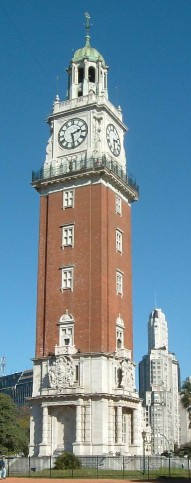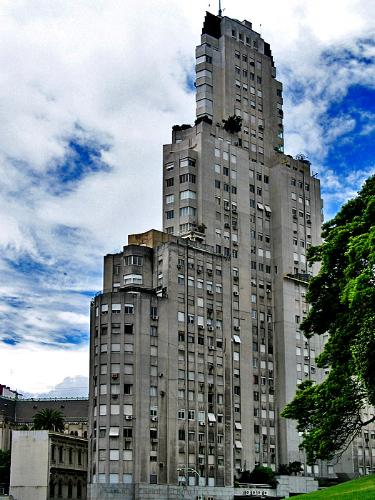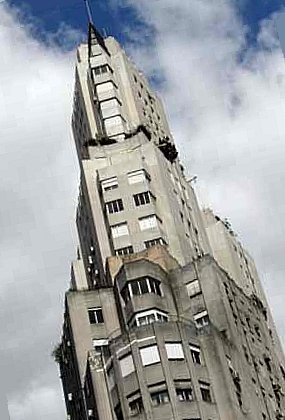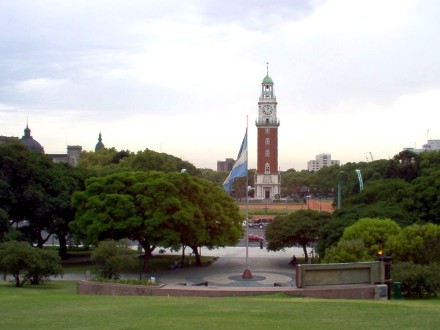
About Andrew Cusack
 Writer, web designer, etc.; born in New York; educated in Argentina, Scotland, and South Africa; now based in London.
Writer, web designer, etc.; born in New York; educated in Argentina, Scotland, and South Africa; now based in London. read more
News
Blogs
Reviews & Periodicals
Arts & Design
World
France
Mitteleuropa
Knickerbockers
Argentina
The Levant
Africa
Cape of Good Hope
Netherlands
Scandinavia
Québec
India
Muscovy
Germany
Academica
The English Tower and Kavanagh Building
 THE SAYING GOES that Argentines are all Italians who speak Spanish and want to be English, which is only just short of the truth. Whatever the quip’s verity, Argentina is a nation of the expatriated and for the centennial year of the 1810 May Revolution, the communities from each of the major mother countries — Spain, Italy, Germany, et cetera — built monuments in dedicated places both to commemorate the contributions their kinsman made to their adopted country as well as to celebrate peace and friendship between Argentina and the given motherland. The Plaza Italia, for example, lamentably bears a monument to the scoundrel Garibaldi, donated by the Italian community.
THE SAYING GOES that Argentines are all Italians who speak Spanish and want to be English, which is only just short of the truth. Whatever the quip’s verity, Argentina is a nation of the expatriated and for the centennial year of the 1810 May Revolution, the communities from each of the major mother countries — Spain, Italy, Germany, et cetera — built monuments in dedicated places both to commemorate the contributions their kinsman made to their adopted country as well as to celebrate peace and friendship between Argentina and the given motherland. The Plaza Italia, for example, lamentably bears a monument to the scoundrel Garibaldi, donated by the Italian community.
For their monumental contribution to the city of Buenos Aires, the English built a tower in the Edwardian style, rather cleverly as it was still the Edwardian period, and the depth of their cleverness was furthered by their naming it the English Tower (officially Torre de los Ingleses, or Tower of the English). Situated in the center of the Plaza Britannia (Britannia Square) at the junction of the San Martin and Libertador avenues, the Tower was designed by engineer Ambrose Poynter and built by Hopkins and Gardom completely (except for mortar) out of materials from England. Around the base are sculptural representations of the English rose, the Scottish thistle, the Welsh dragon, and the Irish shamrock. The dedication at the entrance to the Tower reads “Al Gran Pueblo Argentino. Los residentes británicos. Salud. 25 de mayo 1810-1910” or: “To the Great Argentine People, from the British residents: Salud. May 25, 1810-1910″. Towards the rear of the photo to the right you can see the Kavanagh building (Edificio Kavanagh).

The Kavanagh building is situated on the Plaza San Martin across the avenue from the Plaza Britannia. This 29-storey apartment building was designed by the firm of Sanchez, Lagos, and de la Torre, and was the tallest building in Latin America when built in 1936. The sharp art deco design on an angulated plot is said to resemble a ship at sea, and of course Buenos Aires is a port city — its residents are called porteños after all.
The Kavanagh is unquestionably my favorite ‘modern’ building in Buenos Aires, but then modern architecture has not been kind to the city, at least not in the post-war period (c.f. the National Library). The structures built in the 1950’s were only drab and dull whereas the 60’s and 70’s bore the ill fruits of the ‘lets see how many things we can do with concrete’ trend and tended towards the insidiously hideous rather than the mundane. But no matter however irritating these later obtrusions are, at least Buenos Aires still has the Kavanagh.

Despite the generations of immigration, investment, interbreeding, and cultural interchange, relations between Argentina and Great Britain were somewhat marred, shall we say, by the shameful attempt by the unhinged wing of the Argentine military to annex the Falklands and rename every geographical feature therein (seriously, I’ve seen the maps). When they were done renaming everything in the Falklands (or ‘Malvinas’ as they would have us believe) the craze apparently spread homewards to the capital. The Plaza Britannia was renamed the Plaza Fuerza Aerea Argentina (from Britannia Square to Argentine Air Force Square), while the Torre de los Ingleses was rechristneed the more ambiguous Torre Monumental. In an even more unfriendly move, the Memorial to the Fallen of the ‘Malvinas’ was built in Plaza San Martin facing the English Tower across the street. In the spirit of peace and friendship, especially regarding two countries which have such deep links as Britain and Argentina, the Memorial really ought to be removed and placed in some other suitable location in the city. Until that time, it remains the Plaza Britannia in my books, and as for the ‘Malvinas’, no such place exists.

The ‘Malvinas’ memorial viewed from the rear, with the English Tower across the Avenue.
Search
Instagram: @andcusack
Click here for my Instagram photos.Most Recent Posts
- A Christmas Gift from the Governor December 24, 2024
- Oude Kerk, Amsterdam December 24, 2024
- Gellner’s Prague December 19, 2024
- Monsieur Bayrou December 18, 2024
- Dempsey Heiner, Art Critic December 17, 2024
Most Recent Comments
Book Wishlist
Monthly Archives
Categories



hi,
i´m from Buenos Aires, and i was looking info of the Kavanagh and i ended in your site. i was proud reading a foreigner about my city, but then you commented something about malvinas that its not like you say.
Although its true that the las “dictadura” invaded the islands, and started a foolish and senseless war, the malvinas were part of argentina in the XIX century, and Great Britain colonized it in the same century, so those crazy militars wanted to recover it (not because they were patriots, just because they wanted to remain in the governement for years, tooking this irrational decision) on the other hand, and affortunately that war had a good consecuence, the militars were kicked off and a new democracy begun.
thanks, (sorry if my english its not good)
Well, Mr. Cusack. I am an argentine also. I have found your elegant notes very nice.
Also, I want to let you know that there is at least an argentine that knows that the Falklands are rightfully British. But I guess there are less than ten people around here that think like me.
It is due to jingoistic brainwashing and resentful nature that argentines think like Mr. Akian. This kind of thinking caused the death of many people and the ruin of our country. The beautiful buildings you depict in your blog are just a distant memory of a country that could be great but turned spiteful.
I hope that someday we will be the friends we should be to the British and I apologize for my ignorant countryman.
I hope that someday we will be the friends we should be to the British and I apologize for my ignorant countryman?
¿paisano ignorante?- Estamos todos locos.-
O para ser un verdadero pais tenemos que ser hijos de grandes piratas.-
Que se caracterizaron en su historia, por saquear a otros paises.-
Preguntemosle a los Escoceses que piensan.-
Leandro, tu comentario es realmente el de un pobre tipo sin fundamentos propios.-
Saludos
Ariel
Ariel, ¿qué tiene que ver todo eso? No tenemos que ser hijos de nadie. Esas islas son habitadas por británicos desde hace 180 años y sin dudas no agregarían nada a la enorme geografía argentina, salvo creernos que somos muy vivos si las “recuperásemos”. Los dueños de las islas son quienes viven en ellas por generaciones y generaciones.
Por cierto, deberíamos ser amigos de los británicos, una de las naciones más civilizadas del mundo. De hecho, cuando fuímos amigos de ellos nos fue muy bien, y cuando dejamos de serlo, nos fue muy mal.
En cuanto a los escoceses, se podrán quejar pero les va bastante bien dentro del Reino Unido. ¿O no?
There are two kind of Argentinas. One looks inside, that is the Argentina of the caudillos, that is the Argentina which is a full part of South America, that is the Argentina of failure, of idiotic pride.
There is another Argentina, that was the Argentina that looked outward, that tried to compete and improve, that yearned for real progress.
Unfortunately, for the last 70 years the Argentina that looks inside, the autistic Argentina, has been the real one, with the results we all know.
Estimado Leandro,
Hablas de ignorancia, como yo lo veo eso es una agresión, para todo aquel que no piense como vos.
Hablas de derechos de los isleños porque durante 180 años diversas generaciones han habitado esas islas, podríamos decir que tu ley es la del más fuerte, si invadimos la isla de Pascua, y logramos mantenerla en nuestro poder por 180 años entonces es nuestra! Interesante forma de definir que es ser un país civilizado. En tu forma de pensar hay mucho de nazi, sabias eso?
Armando,
No voy a hacer acá un debate de ciencia política acerca de la forma de establecer a quién o quiénes pertenece una pedazo de tierra (hay una bibliografía más que vasta y la realidad es lo que cuenta) pero, sin dudas, ocupar un lugar y habitarlo con gente de tu idioma y cultura por 180 años es un título bastante fuerte, especialmente si hablamos de un lugar despoblado desde el inicio de los tiempos.
Además, ¿no hicieron lo mismo los españoles? Lo que hoy es la Argentina era un desierto poblado de grupúsculos de nómades paleolíticos. ¿Debemos irnos (¿adónde?) y dejar la Argentina a sus descendientes?
¿Cuál es el problema de que haya británicos en las Falklands? ¿De qué nos perdemos los argentinos? La provincia de Santa Cruz tiene la población de Vicente López ¿Para qué queremos más tierras inhóspitas? ¿Por qué nos cansamos de la visión del mundo de 1935?